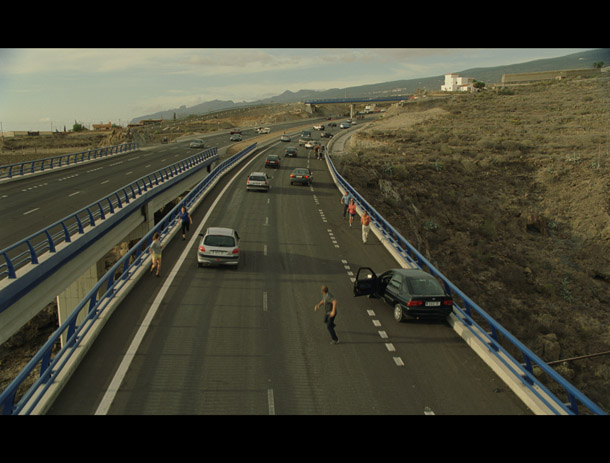NASA researcher turned matte artist Nathalie Mathé
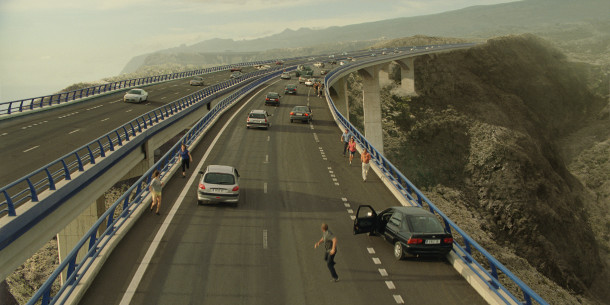
The NASA researcher turned Fast & Furious 6 artist explores the art of matte painting, how technology is changing the field – and how a chance meeting with Ralph McQuarrie led her to her current career path.
 After a successful career as a NASA computer research scientist, Nathalie Mathé discovered the joy of painting and video directing. She first became a documentary director, then worked as a layout artist for several major studios in Paris, including Method Animation and Ankama Animations, and as a texture artist and matte painter for Mac Guff.
After a successful career as a NASA computer research scientist, Nathalie Mathé discovered the joy of painting and video directing. She first became a documentary director, then worked as a layout artist for several major studios in Paris, including Method Animation and Ankama Animations, and as a texture artist and matte painter for Mac Guff.
She moved on to an international career as a matte painter at Double Negative and now Image Engine. Her credits include Cannes award-winner Persepolis, Rémi Bezançon’s Un heureux événement (A Happy Event), Total Recall, The Dark Knight Rises, Les Misérables, Oscar nominee Captain Phillips and Fast & Furious 6. She recently contributed to Zero Point, the first movie ever made for the Occulus Rift VR headset.
In the interview below, she reflects on the lessons learned from a career spanning the worlds of art and science, how the art of matte painting has evolved in response to technology – and how a chance meeting with the legendary Star Wars concept designer Ralph McQuarrie set her on her current career path.
CG Channel: How did you get started in the VFX industry?
Nathalie Mathé: I have a scientific and computer programming background and it was only after working for several years in artificial intelligence research, that I felt the need to explore a more artistic path. I started with evening painting classes, and weekend video shooting and editing classes. I had so much fun the first time I used After Effects that I decided to study for a degree in video production in parallel to my career. I shot and edited my first documentary, which was screened at the Palo Alto Festival in California.
But the turning point was when I visited the Art of Star Wars exhibit in the mid-90s in San Francisco. I suddenly discovered that there were real artists working behind the scenes of movies. What really struck me was when I saw Ralph McQuarrie’s matte paintings. They were huge paintings on glass, bigger than me, and they were so realistic-looking – planets, alien worlds, and all painted by hand by this incredible artist. I attended a special evening reception and talked to Ralph McQuarrie in person. He was already an old guy at the time, but so sweet. I asked him how he got to work on Star Wars in the first place, and he told me that at the time he was working at NASA painting the simulations of the Voyager spacecraft’s journeys through the solar system, and that’s how Georges Lucas recruited him.
Suddenly I felt totally moved, because I was working at NASA too! A brand new possibility opened up for me. It took me several more years to go back to school, study 3D animation and special effects, and build a new career from scratch in the animation and film industry: first in France, my country of origin, then internationally. Nowadays, I am still working with a computer, but as a digital visual artist.
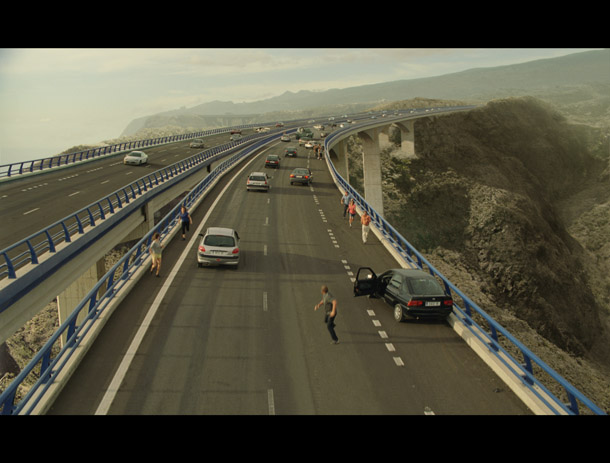
The matte painter’s art: for the tank chase sequence in Fast & Furious 6, Mathé painted out surrounding buildings from the background plate (top) and blended it into a 3D canyon environment (above).
CG Channel: What does your current work involve?
NM: I’m a digital matte painter and texture artist, which means that I paint environments of shots in 2D as well as in 3D. For example, I might destroy buildings, extend environments, remove roads or add mountains – or whatever needs to be there that was not shot in the original scene. In my 3D texture work, I paint surface colours and mimic how materials will respond to lighting on 3D characters, vehicles and buildings.
CG Channel: What determines the choice of technique?
NM: The choice between 2D matte painting or full 3D texturing depends on whether that element is seen several times in a sequence, and whether it is seen under similar or different cameras angles.
Matte painting is often used because it’s faster, and it has become quite powerful with 2.5D projections and moving cameras: it isn’t just a static background any more. Unlike animated features, matte paintings for VFX films are created by digitally manipulating real photographs, not painting from scratch; texturing is more of a mix between the two techniques.
CGC: What part of the process do you find most enjoyable?
NM: I really enjoy the research and design phase for a matte painting, when you try to define the concept for the shot. Sometimes you are given a well-defined concept and there is not much room for creativity, but often, no one knows yet how the shot needs to look. You are given the director’s intention for the shot and some reference photos, but otherwise, the brief may be pretty vague. You need to propose something so that the look gets locked before proceeding to the full-blown matte painting
It’s quite an open phase and it’s very important not to rush it, so that you really immerse yourself in the shot. You need to decide what is needed based on other shots already approved in the sequence, production references, the story being told, and so on. You also need to respect the basics, like perspectives, lighting, and composition.
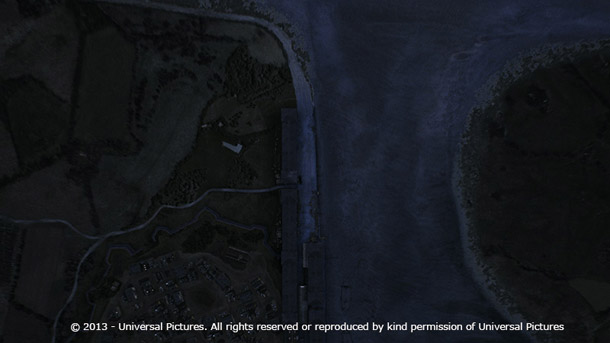
A crucial transition in Les Misérables. The extreme zoom-in from the heavens involved projecting a series of 2D matte paintings onto a 3D model of the terrain, using historical reference from French real estate archives.
For example, in Les Misérables, I worked on a major transition shot when Valjean realises that he must turn his convict life around, with the action then jumping eight years forward to a different location where he has in fact found wealth and become mayor. For the extreme zoom-in shot from the heavens into Montreuil-sur-Mer, I went as far as researching the Napoleonic cadastral registers [real estate records] in French archives to provide the director with accurate historical references of the town and the distribution of the fields around it in the 1830s.
I proposed several concept illustrations that were refined and approved before proceeding to create the final digital matte painting. The work itself was technically complex and involved projecting 2D matte paintings created at various scales and camera angles onto a 3D model of the terrain, so that they matched seamlessly, and integrated with 3D models and renders of the town buildings created by a CG artist. If the look had not been locked first, it would have taken forever to fully revise each matte at different scales.
CGC: What was the proudest moment of your career?
NM: I would say that two of my proudest moments have been working on a small-scale VFX film, A Happy Event (Un heureux événement), at Mac Guff in Paris, and on a full-blown VFX film, Fast & Furious 6, at Double Negative in London. Each time I felt honored and challenged by being given a job I had not done before, and for which I had to come up with innovative and efficient solutions, yet at the same time feeling trusted and fully supported by my supervisors. In each case, this was an opportunity to grow and to work with exceptionally talented artists, and I was very proud of the results.
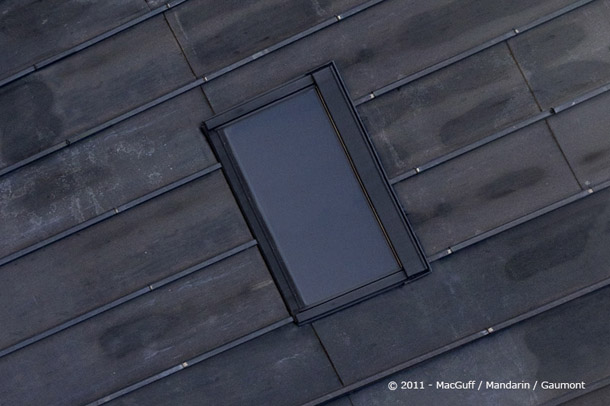
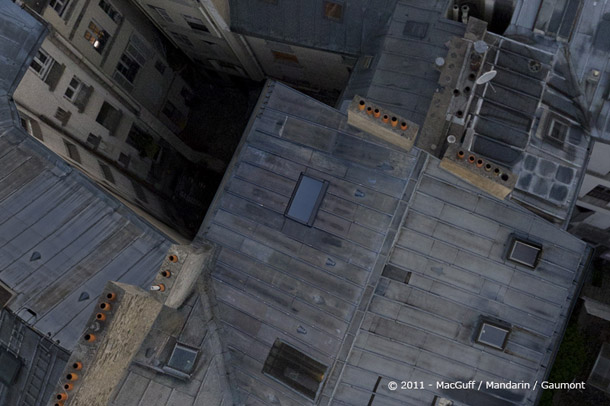
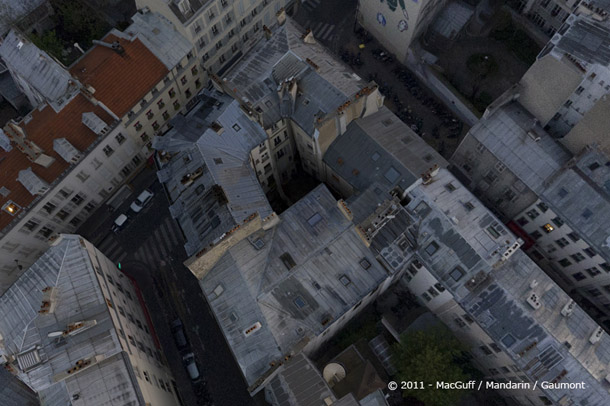
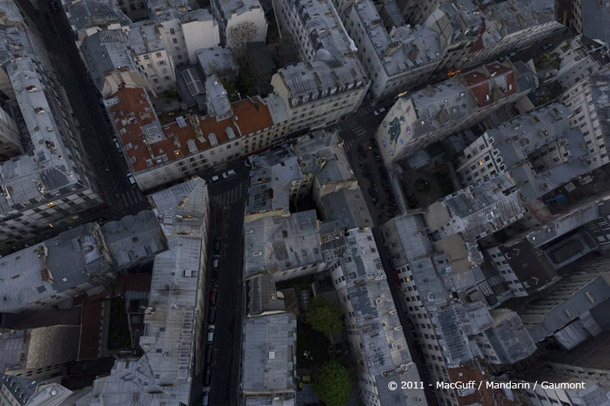
An extreme zoom-out shot from Rémi Bezançon’s A Happy Event. Mattes were created using reference photos shot from a remote-controlled balloon flying above the streets of Paris early in the morning.
On A Happy Event, directed by César award-winner Rémi Bezançon, I created an extreme zoom-out digital shot from a close-up view of a window in the rooftops of Paris to a very wide view encompassing roofs, buildings and streets of several city blocks, to underline the loneliness of the main character lying on the sofa under the window. I blended several matte paintings at different resolutions and angles and reprojected them onto a 3D model of the area I had created. I also animated the 3D camera path to match the first part of the shot inside the room up to the window. The mattes and 3D models were created using photos shot from a remote-controlled balloon flying above the roofs of Paris early in the morning, under changing light conditions – and with a fairly unpredictable path!
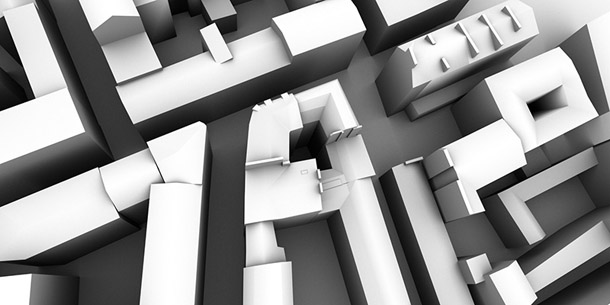
An occlusion render of the geometry used in the shot from A Happy Event. Mathé created a series of matte paintings from different angles and at different resolutions, and reprojected them onto a 3D model of the area.
On Fast & Furious 6, I was the principal digital matte painter for the huge CG environment required for the tank chase sequence in the Canary Islands. The end of the sequence involves a spectacular jump and tank flipping over. Double Negative built a completely digital bridge and a huge digital canyon environment and kept little bits of plate photography that were reprojected back in. We used a helicopter for a couple of days to photograph huge canyons in Tenerife and Gran Canaria. We mapped out specific flight paths for the helicopter using GPS and were able to generate really high-resolution panoramas and photogrammetry-based reconstructions. Once we got all this data back to the studio, we had to rebuild it as a renderable 3D model. Then it was passed on to me to paint the canyon environment onto it.
Given the size of the canyon and the huge amount of data we needed to integrate, I first performed a few tests using different software and methodologies to figure out what would be the most efficient solution, quickly settling on a combination of 3D camera projections and paint work using Mari. I selected about 50 of the 160 helicopter photos that gave the best angle and resolution, projected them onto the 3D geometry of the canyon using the position of the cameras during the helicopter shoot, and then blended them all together so that they matched seamlessly.
At this point, all of the surrounding hotel complexes, roads, fields and houses could still be seen, but Justin Lin, the director, wanted the location to feel more like a desert, and feel more remote, so I painted out all signs of habitation or cultivation from the surroundings, and replaced them with wild natural vegetation and rocks. Finally, we modified the canyon environment to extend it further and make it deeper and more impressive for the final sequence on the bridge. It was then used in almost every shot in the sequence, and I created more matte paintings specific to each shot to naturally blend the 3D environment with the original photography.
CGC: What advice would you give to aspiring matte painters, especially women?
NM: Always follow your heart, no matter how hard it is or what other people tell you. You are the only one to know what’s best for you. Of course, it’s crucial to have talent and keep developing it constantly, trying to work with the best artists on challenging projects, but you also need to learn networking skills, because who you know will make a difference.
Women are still a minority in this industry, although it is much better than 10 years ago when we were only 10% of the workforce. Now it is more like 30-40% depending on the company and project, but there are still very few female leads and supervisors in creative and technical roles.
Visit Nathalie Mathé’s website
Fast & Furious 6 images © 2013 Universal Pictures. Images courtesy of Double Negative.

